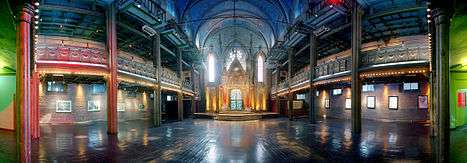Lower East Side
The Lower East Side, sometimes abbreviated as LES, is a neighborhood in the southeastern part of the New York City borough of Manhattan, roughly located between the Bowery and the East River from Canal to Houston streets. Traditionally an immigrant, working class neighborhood, it began rapid gentrification in the mid-2000s, prompting the National Trust for Historic Preservation to place the neighborhood on their list of America's Most Endangered Places.[6][7]
Lower East Side | |
|---|---|
Neighborhood of Manhattan | |
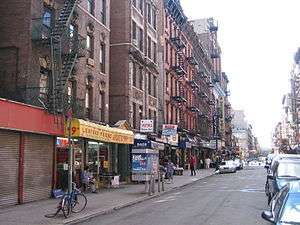 The corner of Orchard and Rivington streets, Lower East Side (2005) | |
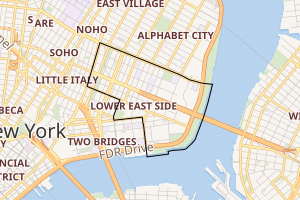
Location in New York City | |
| Coordinates: 40.715°N 73.985°W | |
| Country | |
| State | |
| City | New York City |
| Borough | Manhattan |
| Community District | Manhattan 3[1] |
| Area | |
| • Total | 2.17 km2 (0.837 sq mi) |
| Population (2010)[2] | |
| • Total | 72,957 |
| • Density | 34,000/km2 (87,000/sq mi) |
| Ethnicity | |
| • Hispanic | 39.6% |
| • Asian | 24.9 |
| • White | 22.6 |
| • Black | 10.9 |
| • Other | 2.0 |
| Economics | |
| • Median income | $51,649 |
| Time zone | UTC−5 (Eastern) |
| • Summer (DST) | UTC−4 (EDT) |
| ZIP Codes | 10002 |
| Area code | 212, 332, 646, and 917 |
Lower East Side Historic District | |
| Location | Roughly bounded by East Houston, Essex, Canal, Eldridge, South, and Grand Streets, and the Bowery and East Broadway, Manhattan, New York (original) Roughly along Division, Rutgers, Madison, Henry and Grand Streets (increase) |
| Coordinates | 40°43′2″N 73°59′23″W |
| NRHP reference No. | 00001015 (original) 04000297 (increase) |
| Added to NRHP | September 7, 2000 (original) May 2, 2006 (increase)[5] |
The Lower East Side is part of Manhattan Community District 3 and its primary ZIP Code is 10002.[1] It is patrolled by the 7th Precinct of the New York City Police Department.
Boundaries
The Lower East Side is roughly bounded by the Bowery to the west, East Houston Street to the north, the FDR Drive and East River to the east, and Canal Street to the south. The western boundary below Grand Street veers east off of the Bowery to approximately Essex Street.
The neighborhood is bordered in the south and west by Chinatown – which extends north to roughly Grand Street, in the west by Nolita and in the north by the East Village.[8][9]
Historically, the "Lower East Side" referred to the area alongside the East River from about the Manhattan Bridge and Canal Street up to 14th Street, and roughly bounded on the west by Broadway. It included areas known today as East Village, Alphabet City, Chinatown, Bowery, Little Italy, and NoLIta. Parts of the East Village are still known as Loisaida, a Latino pronunciation of "Lower East Side".
Political representation
Politically, the neighborhood is located in New York's 7th[10] and 12th[11] congressional districts.[12] It is in the New York State Assembly's 65th district and 74th district;[13][14] the New York State Senate's 26th district;[15] and New York City Council's 1st and 2nd districts.[16]
History
Prior to Europeans
As was all of Manhattan Island, the area now known as the Lower East Side was occupied by members of the Lenape tribe, who were organized in bands which moved from place to place according to the seasons, fishing on the rivers in the summer, and moving inland in the fall and winter to gather crops and hunt for food. Their main trail took approximately the route of Broadway. One encampment in the Lower East Side area, near Corlears Hook was called Rechtauck or Naghtogack.[17]
Early settlement
The population of the Dutch colony of New Amsterdam was located primarily below the current Fulton Street, while north of it were a number of small plantations and large farms called bouwerij (bowery) at the time (equivalent to "boerderij" in present-day Dutch). Around these farms were a number of enclaves of free or "half-free" Africans, which served as a buffer between the Dutch and the Native Americans. One of the largest of these was located along the modern Bowery between Prince Street and Astor Place, as well as the "only separate enclave" of this type within Manhattan.[18] These black farmers were some of the earliest settlers of the area.[19]
Gradually, during the 17th century, there was an overall consolidation of the boweries and farms into larger parcels, and much of the Lower East Side was then part of the Delancy farm.[19]
James Delancey's pre-Revolutionary farm east of post road leading from the city (Bowery) survives in the names Delancey Street and Orchard Street. On the modern map of Manhattan, the Delancey farm[20] is represented in the grid of streets from Division Street north to Houston Street.[21] In response to the pressures of a growing city, Delancey began to survey streets in the southern part of the "West Farm"[22] in the 1760s. A spacious projected Delancey Square—intended to cover the area within today's Eldridge, Essex, Hester and Broome Streets—was eliminated when the loyalist Delancey family's property was confiscated after the American Revolution. The city Commissioners of Forfeiture eliminated the aristocratic planned square for a grid, effacing Delancey's vision of a New York laid out like the West End of London.
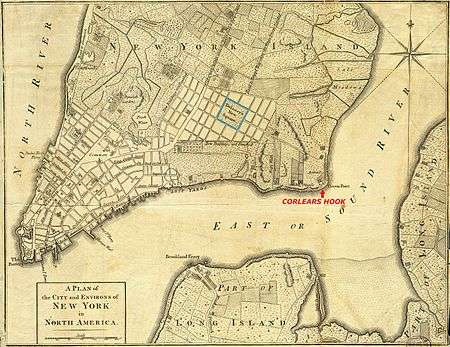
Corlears Hook
The point of land on the East River now called Corlears Hook was also called Corlaers Hook under Dutch and British rule, and briefly Crown Point during British occupation in the Revolution. It was named after the schoolmaster Jacobus van Corlaer, who settled on this "plantation" that in 1638 was called by a Europeanized version of its Lenape name, Nechtans[23] or Nechtanc.[24] Corlaer sold the plantation to Wilhelmus Hendrickse Beekman (1623–1707), founder of the Beekman family of New York; his son Gerardus Beekman was christened at the plantation, on August 17, 1653.
On February 25, 1643, volunteers from the New Amsterdam colony killed thirty[25] Wiechquaesgecks at their encampment at Corlears Hook, as part of Kieft's War, in retaliation for ongoing conflicts between the colonists and the natives of the area, including their unwillingness to pay tribute, and their refusal to turn over the killer of a colonist.[26]
The projection into the East River that retained Corlaer's name was an important landmark for navigators for 300 years. On older maps and documents it is usually spelled Corlaers Hook, but since the early 19th century the spelling has been anglicized to Corlears. The rough unplanned settlement that developed at Corlaer's Hook under the British occupation of New York during the Revolution was separated from the densely populated city by rough hills of glacial till: "this region lay beyond the city proper, from which it was separated by high, uncultivated, and rough hills", observers recalled in 1843.[27]
As early as 1816, Corlears Hook was notorious for streetwalkers, "a resort for the lewd and abandoned of both sexes", and in 1821 its "streets abounding every night with preconcerted groups of thieves and prostitutes" were noted by the "Christian Herald".[28] In the course of the 19th century they came to be called hookers.[29] In the summer of cholera in New York, 1832, a two-storey wooden workshop was commandeered to serve as a makeshift cholera hospital; between July 18 and September 15 when the hospital was closed, as the cholera wound down, 281 patients were admitted, both black and white, of whom 93 died.[30]
In 1833, Corlear's Hook was the location of some of the first tenements built in New York City.[19]
Corlears Hook is mentioned in the opening page of Herman Melville's Moby Dick, first published in 1851: "Circumambulate the city of a dreamy Sabbath afternoon. Go from Corlears Hook to Coenties Slip, and from thence, by Whitehall, northward. What do you see? ..."
The original location of Corlears Hook is now obscured by shoreline landfill.[31] It was near the east end of the present pedestrian bridge over the FDR Drive near Cherry Street. The name is preserved in Corlears Hook Park at the intersection of Jackson and Cherry Streets along the East River Drive.[32]
Immigration
The bulk of immigrants who came to New York City in the late 19th and early 20th centuries came to the Lower East Side, moving into crowded tenements there.[33] By the 1840s, large numbers of German immigrants settled in the area, and a large part of it became known as "Little Germany" or "Kleindeutschland".[19][34] This was followed by groups of Italians and Eastern European Jews, as well as Greeks, Hungarians, Poles, Romanians, Russians, Slovaks and Ukrainians, each of whom settled in relatively homogeneous enclaves. By 1920, the Jewish neighborhood was one of the largest of these ethnic groupings, with 400,000 people, pushcart vendors prominent on Orchard and Grand Streets, and numerous Yiddish theatres along Second Avenue between Houston and 14th Streets.[19]
Living conditions in these "slum" areas were far from ideal, although some improvement came from a change in the zoning laws which required "new law" tenements to be built with air shafts between them, so that fresh air and some light could reach each apartment. Still, reform movements, such as the one started by Jacob A. Riis' book How the Other Half Lives continued to attempt to alleviate the problems of the area through settlement houses, such as the Henry Street Settlement, and other welfare and service agencies. The city itself moved to address the problem when it built First Houses, the first such public housing project in the United States, in 1935-1936. The development, located on the south side of East 3rd Street between First Avenue and Avenue A, and on the west side of Avenue A between East 2nd and East 3rd Streets, is now considered to be located within the East Village.[19]
Societal change and decline
By the turn of the twentieth century, the neighborhood had become closely associated with radical politics, such as anarchism, socialism and communism, and was also known as a place where many popular performers had grown up, such as the Marx Brothers, Eddie Cantor, Al Jolson, George and Ira Gershwin, Jimmy Durante, and Irving Berlin. Later, more radical artists such as the Beat poets and writers were drawn to the neighborhood – especially the parts which later became the East Village – by the inexpensive housing and cheap food.[19]
The German population decreased in the early twentieth century as a result of the General Slocum disaster and due to anti-German sentiment prompted by World War I. After World War II, the Lower East Side became New York City's first racially integrated neighborhood with the influx of African Americans and Puerto Ricans. Areas where Spanish speaking was predominant began to be called Loisaida.[19]
By the 1960s, the influence of the Jewish and eastern European groups declined as many of these residents had left the area, while other ethnic groups had coalesced into separate neighborhood, such as Little Italy. The Lower East Side then experienced a period of "persistent poverty, crime, drugs, and abandoned housing".[19] A substantial portion of the neighborhood was slated for demolition under the Cooper Square Urban Renewal Plan of 1956, which was to redevelop the area from Ninth to Delancey Streets from the Bowery/Third Avenue to Chrystie Street/Second Avenue with new privately owned cooperative housing.[33]:38[35] The United Housing Foundation was selected as the sponsor for the project, which faced great opposition from the community.[36] Neither the original large-scale development nor a 1961 revised proposal were implemented,[33]:39 and it was not until 1991 that an agreement was made to redevelop a small portion of the proposed renewal site.[37]
East Village split and gentrification
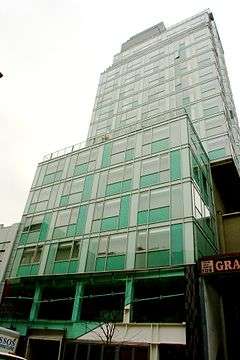

The East Village was once considered the Lower East Side's northwest corner. However, in the 1960s, the demographics of the area above Houston Street began to change, as hipsters, musicians, and artists moved in. Newcomers and real estate brokers popularized the East Village name, and the term was adopted by the popular media by the mid-1960s. As the East Village developed a culture separate from the rest of the Lower East Side, the two areas came to be seen as two separate neighborhoods rather than the former being part of the latter.[38][39]
By the 1980s, the Lower East Side had begun to stabilize after its period of decline, and once again began to attract students, artists and adventurous members of the middle-class, as well as immigrants from countries such as Bangladesh, China, the Dominican Republic, India, Japan, Korea, the Philippines and Poland.[19]
In the early 2000s, the gentrification of the East Village spread to the Lower East Side proper, making it one of the trendiest neighborhoods in Manhattan. Orchard Street, despite its "Bargain District" moniker, is now lined with upscale boutiques. Similarly, trendy restaurants, including Clinton St. Baking Company & Restaurant, Cube 63, and Falai are found on a stretch of tree-lined Clinton Street that New York Magazine described as the "hippest restaurant row" on the Lower East Side.[40][41]
In November 2007, the Blue Condominium, a 32-unit, 16 story luxury condominium tower was completed at 105 Norfolk Street just north of Delancey Street, the pixellated, faceted blue design of which starkly contrasts with the surrounding neighborhood. Following the construction of the Hotel on Rivington one block away, several luxury condominiums around Houston, and the New Museum on Bowery, this new wave of construction is another sign that the gentrification cycle is entering a high-luxury phase similar to in SoHo and Nolita in the previous decade.
More recently, the gentrification that was previously confined to north of Delancey Street continued south. Several restaurants, bars, and galleries opened below Delancey Street after 2005, especially around the intersection of Broome and Orchard Streets. The neighborhood's second boutique hotel, Blue Moon Hotel, opened on Orchard Street just south of Delancey Street in early 2006. However, unlike The Hotel on Rivington, the Blue Moon used an existing tenement building, and its exterior is almost identical to neighboring buildings. In September 2013, it was announced that the Essex Crossing redevelopment project was to be built in the area, centered around the intersection of Essex and Delancey Streets, but mostly utilizing land south of Delancey Street.[42]
Demographics
The census tabulation area for the Lower East Side is bounded to the north by 14th Street and to the west by Avenue B / Norfolk Street / Essex Street / Pike Street (in southbound order). Based on data from the 2010 United States Census, the population of Lower East Side was 72,957, an increase of 699 (1.0%) from the 72,258 counted in 2000. Covering an area of 535.91 acres (216.88 ha), the neighborhood had a population density of 136.1 inhabitants per acre (87,100/sq mi; 33,600/km2).[2] The racial makeup of the neighborhood was 22.6% (16,453) White, 10.9% (7,931) African American, 0.2% (142) Native American, 24.9% (18,166) Asian, 0.0% (13) Pacific Islander, 0.3% (191) from other races, and 1.6% (1,191) from two or more races. Hispanic or Latino of any race were 39.6% (28,870) of the population.[3]
The racial composition of the Lower East Side changed moderately from 2000 to 2010, with the most significant changes being the White population's increase by 18% (2,514), the Asian population's increase by 10% (1,673), and the Hispanic / Latino population's decrease by 10% (3,219). The minority Black population experienced a slight increase by 1% (41), while the very small population of all other races decreased by 17% (310).[43]
The Lower East Side lies in Manhattan Community District 3, which encompasses the Lower East Side, the East Village and Chinatown, bounded to the north by 14th Street and to the west by Fourth Avenue / Cooper Square / Bowery (in southbound order) north of Canal Street and Baxter Street / Pearl Street south of it. Community District 3 had 171,103 inhabitants as of NYC Health's 2018 Community Health Profile, with an average life expectancy of 82.2 years.[44]:2, 20 This is higher than the median life expectancy of 81.2 for all New York City neighborhoods.[45]:53 (PDF p. 84) Most inhabitants are adults: a plurality (35%) are between the ages of 25–44, while 25% are between 45–64, and 16% are 65 or older. The ratio of youth and college-aged residents was lower, at 13% and 11% respectively.[44]:2
As of 2017, the median household income in Community District 3 was $39,584,[46] though the median income in the Lower East Side individually was $51,649.[4] In 2018, an estimated 18% of Community District 3 residents lived in poverty, compared to 14% in all of Manhattan and 20% in all of New York City. One in twelve residents (8%) were unemployed, compared to 7% in Manhattan and 9% in New York City. Rent burden, or the percentage of residents who have difficulty paying their rent, is 48% in Community District 3, compared to the boroughwide and citywide rates of 45% and 51% respectively. Based on this calculation, as of 2018, Community District 3 is considered to be gentrifying: according to the Community Health Profile, the district was low-income in 1990 and has seen above-median rent growth up to 2010.[44]:7
Culture

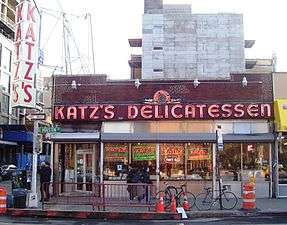
Immigrant neighborhood
One of the oldest neighborhoods of the city, the Lower East Side has long been a lower-class worker neighborhood and often a poor and ethnically diverse section of New York. As well as Irish, Italians, Poles, Ukrainians, and other ethnic groups, it once had a sizeable German population and was known as Little Germany (Kleindeutschland). Today it is a predominantly Puerto Rican and Dominican community, and in the process of gentrification (as documented by the portraits of its residents in the Clinton+Rivington chapter of The Corners Project.)[47]
Since the immigration waves from eastern Europe in the late 19th and early 20th century, the Lower East Side became known as having been a center of Jewish immigrant culture. In her 2000 book Lower East Side Memories: A Jewish Place in America, Hasia Diner explains that the Lower East Side is especially remembered as a place of Jewish beginnings for Ashkenazi American Jewish culture.[48] Vestiges of the area's Jewish heritage exist in shops on Hester and Essex Streets, and on Grand Street near Allen Street. An Orthodox Jewish community is based in the area, operating yeshiva day schools and a mikvah. A few Judaica shops can be found along Essex Street and a few Jewish scribes and variety stores. Some kosher delis and bakeries, as well as a few "kosher style" delis, including the famous Katz's Deli, are located in the neighborhood. Second Avenue in the Lower East Side was home to many Yiddish theatre productions in the Yiddish Theater District during the early part of the 20th century, and Second Avenue came to be known as "Yiddish Broadway," though most of the theaters are gone. Songwriter Irving Berlin, actor John Garfield, and singer Eddie Cantor grew up here.
Since the mid-20th century, the area has been settled primarily by immigrants, primarily from Latin America, especially Central America and Puerto Rico. They have established their own groceries and shops, marketing goods from their culture and cuisine. Bodegas have replaced Jewish shops. They are mostly Roman Catholic.
In what is now the East Village, the earlier populations of Poles and Ukrainians have moved on and been largely supplanted by newer immigrants. The immigration of numerous Japanese people over the last fifteen years or so has led to the proliferation of Japanese restaurants and specialty food markets. There is also a notable population of Bangladeshis and other immigrants from Muslim countries, many of whom are congregants of the small Madina Masjid (Mosque), located on First Avenue and 11th Street.
The neighborhood still has many historic synagogues, such as the Bialystoker Synagogue,[49] Beth Hamedrash Hagadol, the Eldridge Street Synagogue,[50] Kehila Kedosha Janina (the only Greek synagogue in the Western Hemisphere),[51] the Angel Orensanz Center (the fourth oldest synagogue building in the United States), and various smaller synagogues along East Broadway. Another landmark, the First Roumanian-American congregation (the Rivington Street synagogue) partially collapsed in 2006, and was subsequently demolished. In addition, there is a major Hare Krishna temple and several Buddhist houses of worship.
Chinese residents have also been moving into Lower East Side, and since the late 20th century, they have comprised a large immigrant group in the area. The part of the neighborhood south of Delancey Street and west of Allen Street has, in large measure, become part of Chinatown. Grand Street is one of the major business and shopping streets of Chinatown. Also contained within the neighborhood are strips of lighting and restaurant supply shops on the Bowery.
Jewish neighborhood
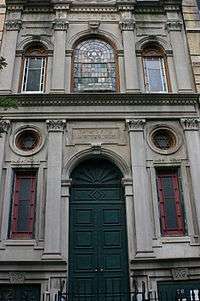
While the Lower East Side has been a place of successive immigrant populations, many American Jews relate to the neighborhood in a strong manner, and Chinatown holds a special place in the imagination of Chinese Americans,[52][53] just as Astoria in Queens holds a place in the hearts of Greek Americans. It was a center for the ancestors of many people in the metropolitan area, and it was written about and portrayed in fiction and films.
In the late twentieth century, Jewish communities have worked to preserve a number of buildings associated with the Jewish immigrant community.[54][55][56]
Landmarks include:
- The Educational Alliance Settlement house – 175 East Broadway
- Henry Street Settlement – 263–267 Henry Street and 466 Grand Street[57]
- University Settlement House 184 Eldridge Street
- Katz's Deli – 205 East Houston Street
- Guss' Pickles – 87 Orchard Street
- Kossar's Bialys – 367 Grand Street[58]
- Gertel's Bake Shop – formerly at 53 Hester Street from 1914 until it closed in 2007[59]
- Knickerbocker Village – 10 Monroe Street
- Streit Matzo Co. – 150 Rivington Street
- Yonah Shimmel's Knish Bakery – 137 East Houston Street[60]
- Harris Levy Fine Linens since 1894 - 98 Forsyth Street
- Russ & Daughters – 179 East Houston Street[61]
- Schapiro's Kosher Wine – Essex Street Market
- Forward Building
Synagogues include:
- Bialystoker Synagogue – 7–11 Willet Street
- Beth Hamedrash Hagadol – 60–64 Norfolk Street
- Eldridge Street Synagogue – 12 Eldridge Street
- Kehila Kedosha Janina – 280 Broome Street
- Angel Orensanz Center – the fourth-oldest synagogue building in the United States.
- Congregation Chasam Sopher
- Meseritz Synagogue
- Stanton Street Synagogue
- Boyaner kloiz at 247 East Broadway, opened in 1928 by the Boyaner Rebbe of New York
Little Fuzhou, Chinatown

Little Fuzhou (Chinese: 小福州; pinyin: Xiǎo Fúzhōu; Foochow Romanized: Siēu-hók-ciŭ), or Fuzhou Town (Chinese: 福州埠; pinyin: Fúzhōu Bù; Foochow Romanized: Hók-ciŭ-pú) is a neighborhood within the eastern sliver of Chinatown, in the Two Bridges and Lower East Side areas of Manhattan. Starting in the 1980s and especially in the 1990s, the neighborhood became a prime destination for immigrants from Fuzhou, Fujian, China. Manhattan's Little Fuzhou is centered on East Broadway. However, since the 2000s, Chinatown, Brooklyn became New York City's new primary destination for the Fuzhou immigrants evolving a second Little Fuzhou of the city and has now far surpassed as being the largest Fuzhou cultural center of the New York metropolitan area and still rapidly growing in contrast to Manhattan's Little Fuzhou, which is now undergoing gentrification.
Since the 2010s, the Fuzhou immigrant population and businesses have been declining throughout the whole eastern portion of Manhattan's Chinatown due to the gentrification. There is a rapidly increasing influx of high income professionals moving into this area, often non-Chinese, including high end hipster-owned businesses.[62][63]
Art scene
The neighborhood has become home to numerous contemporary art galleries. One of the very first was ABC No Rio.[64] Begun by a group of Colab no wave artists (some living on Ludlow Street), ABC No Rio opened an outsider gallery space that invited community participation and encouraged the widespread production of art. Taking an activist approach to art that grew out of The Real Estate Show (the take over of an abandoned building by artists to open an outsider gallery only to have it chained closed by the police) ABC No Rio kept its sense of activism, community, and outsiderness. The product of this open, expansive approach to art was a space for creating new works that did not have links to the art market place and that were able to explore new artistic possibilities.
Other outsider galleries sprung up throughout the Lower East Side and East Village—some 200 at the height of the scene in the 1980s, including the 124 Ridge Street Gallery among others. In December 2007, the New Museum relocated to a brand-new, critically acclaimed building on Bowery at Prince. A growing number of galleries are opening in the Bowery neighborhood to be in close proximity to the museum. The Museum of Reclaimed Urban Space, which opened in 2012, exhibits photography featuring the neighborhood in addition to chronicling its history of activism.
Social service agencies like Henry Street Settlement and Educational Alliance have visual and performing arts programs, the former at Abrons Arts Center, a home for contemporary interdisciplinary arts.
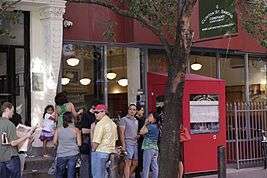
The neighborhood is also home to several graffiti artists, such as Chico and Jean-Michel Basquiat.
Nightlife and live music
As the neighborhood gentrified and has become safer at night, it has become a popular late night destination. Orchard, Ludlow and Essex between Rivington Street and Stanton Street have become especially packed at night, and the resulting noise is a cause of tension between bar owners and longtime residents.[65][66] However, as gentrification continues, many established landmarks and venues have been lost.[67]
The Lower East Side is also home to many live music venues. Punk bands played at C-Squat and alternative rock bands play at Bowery Ballroom on Delancey Street and Mercury Lounge on East Houston Street. Punk bands play at Otto's Shrunken Head and R-Bar. Punk and alternative bands play at Bowery Electric just north of the old CBGB's location.[68] There are also bars that offer performance space, such as Pianos on Ludlow Street and Arlene's Grocery on Stanton Street.
The Lower East Side is the location of the Slipper Room a burlesque, variety and vaudeville theatre on Orchard and Stanton. Lady Gaga, Leonard Cohen and U2 have all appeared there, while popular downtown performers Dirty Martini, Murray Hill and Matt Fraser often appear. Variety shows are regularly hosted by comedians James Habacker, Bradford Scobie, Matthew Holtzclaw and Matt Roper under the guise of various characters.
Police and crime
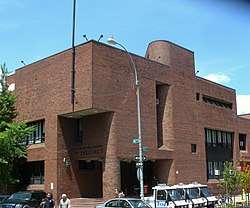
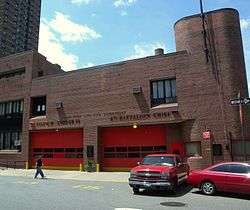
The Lower East Side is patrolled by the 7th Precinct of the NYPD, located at 19 1⁄2 Pitt Street.[69] The 7th Precinct, along with the neighboring 5th Precinct, ranked 48th safest out of 69 patrol areas for per-capita crime in 2010.[70] With a non-fatal assault rate of 42 per 100,000 people, the Lower East Side and East Village's rate of violent crimes per capita is less than that of the city as a whole. The incarceration rate of 449 per 100,000 people is higher than that of the city as a whole.[44]:8
The 7th Precinct has a lower crime rate than in the 1990s, with crimes across all categories having decreased by 64.8% between 1990 and 2019. The precinct reported 0 murders, 7 rapes, 149 robberies, 187 felony assaults, 94 burglaries, 507 grand larcenies, and 18 grand larcenies auto in 2019.[71]
Fire safety
The Lower East Side is served by two New York City Fire Department (FDNY) fire stations:[72]
Health
Preterm and teenage births are less common in the Lower East Side and East Village than in other places citywide. In the Lower East Side and East Village, there were 82 preterm births per 1,000 live births (compared to 87 per 1,000 citywide), and 10.1 teenage births per 1,000 live births (compared to 19.3 per 1,000 citywide).[44]:11 The Lower East Side and East Village have a low population of residents who are uninsured. In 2018, this population of uninsured residents was estimated to be 11%, slightly less than the citywide rate of 12%.[44]:14
The concentration of fine particulate matter, the deadliest type of air pollutant, in the Lower East Side and East Village is 0.0089 milligrams per cubic metre (8.9×10−9 oz/cu ft), more than the city average.[44]:9 Twenty percent of Lower East Side and East Village residents are smokers, which is more than the city average of 14% of residents being smokers.[44]:13 In the Lower East Side and East Village, 10% of residents are obese, 11% are diabetic, and 22% have high blood pressure—compared to the citywide averages of 24%, 11%, and 28% respectively.[44]:16 In addition, 16% of children are obese, compared to the citywide average of 20%.[44]:12
Eighty-eight percent of residents eat some fruits and vegetables every day, which is about the same as the city's average of 87%. In 2018, 70% of residents described their health as "good," "very good," or "excellent," less than the city's average of 78%.[44]:13 For every supermarket in the Lower East Side and East Village, there are 18 bodegas.[44]:10
The nearest major hospitals are Beth Israel Medical Center in Stuyvesant Town, as well as the Bellevue Hospital Center and NYU Langone Medical Center in Kips Bay, and NewYork-Presbyterian Lower Manhattan Hospital in the Civic Center area.[75][76] In addition, FDNY EMS Division 1/Station 4 is located on Pier 39.
Post offices and ZIP Code
The Lower East Side is located within the ZIP Code 10002.[77] The United States Postal Service operates two post offices in the Lower East Side:
- Knickerbocker Station – 128 East Broadway[78]
- Pitt Station – 185 Clinton Street[79]
Education
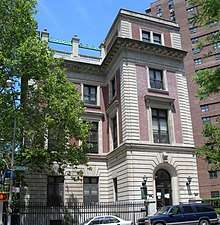
The Lower East Side and East Village generally have a higher rate of college-educated residents than the rest of the city. A plurality of residents age 25 and older (48%) have a college education or higher, while 24% have less than a high school education and 28% are high school graduates or have some college education. By contrast, 64% of Manhattan residents and 43% of city residents have a college education or higher.[44]:6 The percentage of Lower East Side and East Village students excelling in math rose from 61% in 2000 to 80% in 2011, and reading achievement increased from 66% to 68% during the same time period.[80]
The Lower East Side and East Village's rate of elementary school student absenteeism is lower than the rest of New York City. In the Lower East Side and East Village, 16% of elementary school students missed twenty or more days per school year, less than the citywide average of 20%.[45]:24 (PDF p. 55)[44]:6 Additionally, 77% of high school students in the Lower East Side and East Village graduate on time, more than the citywide average of 75%.[44]:6
Schools
The New York City Department of Education operates public schools in the Lower East Side as part of Community School District 1.[81] District 1 does not contain any zoned schools, which means that students living in District 1 can apply to any school in the district, including those in the East Village.[82][83]
The following public elementary schools are located in the Lower East Side, serving grades PK-5 unless otherwise indicated:[81]
- New Explorations Into Science Tech and Math (NEST+m) (grades K-12)[84]
- PS 1 Alfred E Smith[85]
- PS 2 Meyer London[86]
- PS 20 Anna Silver[87]
- PS 42 Benjamin Altman[88]
- PS 110 Florence Nightingale[89]
- PS 134 Henrietta Szold[90]
- PS 142 Amalia Castro[91]
The following public elementary/middle schools are located in the Lower East Side, serving grades PK-8 unless otherwise indicated:[81]
- PS 126 Jacob August Riis[92]
- PS 140 Nathan Straus[93]
- PS 184 Shuang Wen[94]
The following public middle and high schools are located in the Lower East Side:[81]
- Murry Bergtraum High School for Business Careers (grades 9-12)[95]
- Orchard Collegiate Academy (grades 9-12)[96]
- School for Global Leaders (grades 6-8)[97]
- University Neighborhood Middle School (grades 5-8)[98]
The Lower East Side Preparatory High School (LESPH) and Emma Lazarus High School (ELHS) are second-chance schools that enable students, aged 17–21, to obtain their high school diplomas. LESPH is a bilingual Chinese-English school with a high proportion of Asian students. ELHS' instructional model is English-immersion with an ethnically diverse student body.
The Seward Park Campus comprises five schools with an average graduation rate of about 80%. The original school in the building was opened 1929 and closed 2006.[99]
Libraries
The New York Public Library (NYPL) operates two branches in the Lower East Side. The Seward Park branch is located at 4192 East Broadway. It was founded by the Aguilar Free Library Society in 1886, and the current three-story Carnegie library building was opened in 1909 and renovated in 2004.[100] The Hamilton Fish Park branch is located at 415 East Houston Street. It was originally built as a Carnegie library in 1909, but was torn down when Houston Street was expanded; the current one-story structure was completed in 1960.[101]
Parks
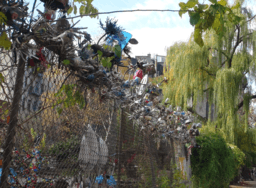
The Lower East Side is home to many private parks, such as La Plaza Cultural.[102] There are several public parks in the area, including Sara D. Roosevelt Park between Chrystie and Forsyth Streets from Houston to Canal Streets,[103] as well as Seward Park on Essex Street between Hester Street and East Broadway.[104]
The East River shorefront contains the John V. Lindsay East River Park, a public park running between East 12th Street in the East Village and Montgomery Street in the Lower East Side.[105] Planned for the waterfront is Pier 42, the first section of which is scheduled to open in 2021.[106]
Transportation
There are multiple New York City Subway stations in the neighborhood, including Grand Street (B and D trains), Bowery (J and Z trains), Second Avenue (F and <F> trains), Delancey Street–Essex Street (F, <F>, J, M, and Z trains), and East Broadway (F and <F> trains).[107] New York City Bus routes include M9, M14A SBS, M14D SBS, M15, M15 SBS, M21, M22, M103 and B39.[108]
The Williamsburg Bridge and Manhattan Bridge connect the Lower East Side to Brooklyn. The FDR Drive is on the neighborhood's south and east ends.[109]
As of 2018, thirty-seven percent of roads in the Lower East Side have bike lanes.[44]:10 Bike lanes are present on Allen, Chrystie, Clinton, Delancey, Grand, Houston, Montgomery, Madison, Rivington, Stanton, and Suffolk Streets; Bowery, East Broadway, and FDR Drive; the Williamsburg and Manhattan bridges; and the East River Greenway.[110]
The Lower East Side is served by NYC Ferry's Lower East Side route, which stops at Corlears Hook in the East River Park.[111] The service started operating on August 29, 2018.[112][113]
In popular culture
Children's literature
- All-of-a-Kind Family, a five-book series by Sydney Taylor first published from 1951 to 1978[114]
- The House on the Roof; A Sukkot Story by David A. Adler
- Rebecca Rubin, a character in the American Girl doll and book series, is a Jewish girl growing up in an immigrant family in 1914.[115]
Novels
- Low Life by Luc Sante[116]
- Bread Givers by Anzia Yezierska[117]
- Lush Life by Richard Price[118]
- Ragtime by E. L. Doctorow
- The Basketball Diaries by Jim Carroll
- Wonder by R.J. Palacio
- Call It Sleep by Henry Roth
Songs
- "Slum Goddess" by The Fugs
- "Ballad Of The Lower East Side" by Michael Monroe
- "Beautiful Night" by B2ST
- "Clinton St Girl" by Wakey!Wakey!
- "Down on the Lower East Side" by Justin Townes Earle
- "East Side Beat" by The Toasters
- "East Side Story" by Emily King
- "For My Family" by Agnostic Front
- "Heavy Metal Lover" by Lady Gaga
- "In the Flesh" by Blondie
- "L.E.S. Artistes" by Santigold
- "L.E.S." by Childish Gambino (aka Donald Glover)
- "Living in L.E.S." by INDK
- "Lower East Side Crew" by Warzone
- "Lower East Side" by David Peel
- "The Luckiest Guy On The Lower East Side" by The Magnetic Fields
- "Ludlow St" by Julian Casablancas
- "Ludlow Street" by Suzanne Vega
- "Marry the Night" by Lady Gaga
- "New York City Tonight" by GG Allin
- "She Took a Lot of Pills (And Died)" by Robbie Fulks
- "Southside" by Fun Lovin' Criminals
- "What's My Name?" by Rihanna ft. Drake
- "Veni Vidi Vici" by Madonna
- Motor-Cycle LP by Lotti Golden
- David Peel & the Lower East Side Band, an early punk band
- Gogol Bordello, a gypsy punk band from the area
- The Holy Modal Rounders, a freak-folk band in the 1960s
- Nausea, a crust punk band in the late 1980s and early 1990s
Plays
- Secret History of the Lower East Side by Alice Tuan[119]
- Welcome to Arroyo's by Kristoffer Diaz[120]
Films
- Alphabet City
- Batteries Not Included
- Beautiful Losers
- Before We Go
- Cloverfield
- The Cobbler
- The Corruptor
- Crossing Delancey[121]
- Date Night
- Die Hard with a Vengeance
- Donnie Brasco
- Downtown 81
- Frogs for Snakes
- Gangs of New York
- The Girl Is in Trouble
- Hester Street[122]
- His People
- I Am Legend
- The Italian
- Johnny Dangerously
- Lucky Number Slevin
- Married to the Mob
- Men In Black
- Mixed Blood
- The Naked City
- Nick and Norah's Infinite Playlist
- The Night They Raided Minsky's
- Once Upon a Time in America
- P.S. I Love You
- Raising Victor Vargas
- Rent
- Rhythm Thief
- Sex and the City
- Taxi Driver
- The Wolfpack
- When Harry Met Sally...
Television
- The Andy Milonakis Show
- Flight of the Conchords (TV series)
- Forever[123][124][125]
- Gossip Girl
- How To Make It In America
- Mr. Robot
- Breadwinners parodies the Lower East Side as the "Lower Yeast Side."
- Masters of None
Video games
Music videos
- "Can't Hold Us Down" by Christina Aguilera
- "I'll Be Loving You Forever" by New Kids On The Block
- "Darling It's True" by Locksley
- "It Ain't Hard to Tell" by Nas
Notable residents
- Adrienne Bailon (born 1983), recording artist and actress[126]
- George Barris (1922–2016), photographer best known for his photographs of Marilyn Monroe.[127]
- Sy Berger (1923–2014), baseball card designer with Topps[128]
- Joseph B. Bloomingdale (1842–1904) and Lyman G. Bloomingdale (1841–1905), co-founders of Bloomingdale's[129]
- Arlyne Brickman (born 1934), former mafia informant and prostitute[130]
- George Burns (1896–1996), comedian and actor[131]
- James Cagney (1899–1986), actor[132]
- Michael Che (born 1983), comedian and actor[133]
- Joshua Lionel Cowen (1877-1965), inventor and founder of Lionel Corporation, toy train manufacturer.[134]
- Jimmy Durante (1893–1980), singer, pianist, comedian and actor[135]
- Monk Eastman (1875–1920), gangster who ran the Eastman Gang[136]
- Miriam Friedlander (1914-2009), activist, elected official
- Lady Gaga (born 1986), singer, songwriter, actress
- John Garfield (1913-1952), actor
- Luis Guzmán (born 1956), actor
- Stephen Grammauta (born 1916)
- Ben Gazzara (1930–2012), actor, director
- George Gershwin (1898–1937), composer, pianist
- Vincent Gigante (1928–2005)
- Lotti Golden (born 1949)
- Marcus Goldman (1821–1904), banker, businessman, financier
- Ralph Goldstein (1913–1997), Olympic épée fencer[137]
- Ruby Goldstein (1907–1984)
- Samuel Gompers (1850-1924), labor union leader
- Rocky Graziano (1919–1990), professional boxer
- Samuel Greenberg (1893-1917), poet
- David Greenglass (1922–2014)
- Sally Gross
- Maggie Gyllenhaal
- Yip Harburg (1896-1981), songwriter
- Jane Katz, Olympic swimmer[138]
- Jack Kirby
- Fiorello LaGuardia (1882–1947), politician, renowned reform mayor of New York City
- Meyer Lansky
- Emanuel Lehman
- Henry Lehman
- Mayer Lehman
- Saul Leiter, photographer and painter
- Lucky Luciano
- Sidney Lumet (1924-2011), filmmaker[139]
- Joseph Mankiewicz (1909-1993) Academy Award-winning director, producer, and screenwriter
- The Marx Brothers (active 1905-1949), comic stars of vaudeville and film
- Jackie Mason (born 1931), comedian and actor
- Walter Matthau (1920-2000), film actor, often paired with Jack Lemmon
- Julia Migenes
- Zero Mostel (1915-1977), comic stage and film actor
- Jim Neu
- Mikhail Odnoralov
- Charlie Parker (1920-1955) musician
- Genesis P-Orridge (born 1950), British singer-songwriter, musician, co-founder of Throbbing Gristle
- Lady Jaye Breyer P-Orridge (born 1950), British singer-songwriter, musician, co-founder of Throbbing Gristle
- Anthony Provenzano
- Lee Quiñones
- Lou Reed (1942-2013), musician, singer, songwriter, co-founder of The Velvet Underground, seminal New York City avant garde rock band
- Edward G. Robinson (1893-1973), film star, first became well-known for playing gangsters
- Sonny Rollins
- Joseph Seligman
- Bugsy Siegel (1906-1947), mobster, known for developing the Las Vegas Strip
- Sheldon Silver (born 1944), former Speaker of the New York State Assembly.[140]
- Al Singer (1909-1961), boxer[141]
- Mose Solomon (1900-1966), the "Rabbi of Swat", American major league baseball player
- David South, musician and filmmaker
- John Spacely (died 1993), musician, actor and nightlife personality whose life was chronicled in two Lech Kowalski documentaries, Story of a Junkie and Born To Lose: The Last Rock and Roll Movie.[142]
- Ysanne Spevack, British composer, conductor, arranger, and food writer, changed her name to Meena Ysanne in 2018
- Johnny Thunders, guitarist, singer and songwriter, came to fame with the New York Dolls
- Rachel Trachtenburg (born 1993), musician, singer, actress, model, former radio host and activist.
- Luther Vandross (1951-2005), singer and songwriter
- B. D. Wong (born 1960), actor
- Christopher Woodrow (born 1977), financier[143]
See also
- Alife Rivington Club
- Cooperative Village
- Grand Street Settlement
- East Side (Manhattan)
- East Side Hebrew Institute (ESHI)
- East Village/Lower East Side Historic District
- First Houses
- Henry Street Settlement
- Lower East Side Conservancy
- Lower East Side History Project
- Lower East Side Tenement Museum
- Moshe Feinstein
- Museum of Reclaimed Urban Space
- Ray's Candy Store
- TEATRO SEA
- Tompkins Square Park
- University Settlement House
References
Notes
- "NYC Planning | Community Profiles". communityprofiles.planning.nyc.gov. New York City Department of City Planning. Retrieved March 18, 2019.
- Table PL-P5 NTA: Total Population and Persons Per Acre - New York City Neighborhood Tabulation Areas*, 2010, Population Division - New York City Department of City Planning, February 2012. Accessed June 16, 2016.
- Table PL-P3A NTA: Total Population by Mutually Exclusive Race and Hispanic Origin - New York City Neighborhood Tabulation Areas*, 2010, Population Division - New York City Department of City Planning, March 29, 2011. Accessed June 14, 2016.
- "Lower East Side neighborhood in New York". Retrieved March 18, 2019.
- "National Register Information System". National Register of Historic Places. National Park Service. April 15, 2008.
- "Threats to history seen in budget cuts, bulldozers – Yahoo! News". News.yahoo.com. Archived from the original on June 3, 2008. Retrieved March 16, 2010.
- Salkin, Allen (June 3, 2007). "Lower East Side Is Under a Groove". The New York Times. p. 1. Retrieved October 6, 2012.
- Virshup, Amy. "New York Nabes". The New York Times. Retrieved January 13, 2007.
- McEvers, Kelly (March 2, 2005). "Close-Up on the Lower East Side". Village Voice. Archived from the original on October 23, 2006. Retrieved January 13, 2007.
- Congressional District 7, New York State Legislative Task Force on Demographic Research and Reapportionment. Accessed May 5, 2017.
- Congressional District 12, New York State Legislative Task Force on Demographic Research and Reapportionment. Accessed May 5, 2017.
- New York City Congressional Districts, New York State Legislative Task Force on Demographic Research and Reapportionment. Accessed May 5, 2017.
- Assembly District 65, New York State Legislative Task Force on Demographic Research and Reapportionment. Accessed May 5, 2017.
- Assembly District 74, New York State Legislative Task Force on Demographic Research and Reapportionment. Accessed May 5, 2017.
- Senate District 26, New York State Legislative Task Force on Demographic Research and Reapportionment. Accessed May 5, 2017.
- Current City Council Districts for New York County, New York City. Accessed May 5, 2017.
- Brazee (2012), p.8
- Brazee (2012), p.8-9
- Hodges, Graham. "Lower East Side" in Jackson, Kenneth T., ed. (2010). The Encyclopedia of New York City (2nd ed.). New Haven: Yale University Press. ISBN 978-0-300-11465-2., pp.769-770
- The Delancey town house later became Fraunces Tavern.
- "Gilbert Tauber, "Old Streets of New York: Delancey Farm grid"". Oldstreets.com. Retrieved May 14, 2011.
- The division between the "West Farm" and the "East farm" ran approximately along today's Clinton Street, according to Eric Homberger, The Historical Atlas of New York City: a visual celebration of nearly 400 years 2005:60–61.
- Van Winkle, Edward; Vinckeboons, Joan; van Rensselaer, Kiliaen. Manhattan, 1624–1639 1916:13; Jacob, whose name was anglicised as "van Curler", leased it to William Hendriesen and Gysbert Cornelisson in September 1640; date given as "prior to 1640": "Corlears Park". Nycgovparks.org. November 17, 2001. Retrieved March 16, 2010.
- Nechtanc, in K. Scott and K. Stryker-Rodda, eds. New York Historical Manuscripts: Dutch, vol. 1 (Baltimore) 1974 and R.S. Grumet, Native American Place-Names in New York City (New York) 1981, both noted in Eric W. Sanderson, Mannahatta: A Natural History of New York City 2009:262.
- Newcomb, Steven (August 24, 2013). "A Dutch Massacre of Our Lenape Ancestors on Manhattan".
- Burrows, Edwin G. & Wallace, Mike (1999). Gotham: A History of New York City to 1898. New York: Oxford University Press. pp. 38–39. ISBN 0-195-11634-8.
- Edwin Francis Hatfield, Samuel Hanson Cox, Patient Continuance in Well-doing: a memoir of Elihu W. Baldwin, 1843:183.
- Edwin Francis Hatfield, Samuel Hanson Cox, Patient Continuance in Well-doing: a memoir of Elihu W. Baldwin, 1843:183f.
- Bartlett's Dictionary of Americanisms (1859): "hooker": 'A resident of the Hook, i.e. a strumpet, a sailor's trull. So called from the number of houses of ill-fame frequented by sailors at the Hook (i.e. Corlears Hook) in the city of New York" (quoted in the Online Etymology Dictionary); thus the usage precedes the Civil War and any supposed connection to Maj.-Gen. Joseph Hooker.
- Samuel Akerley, MD (Dudley Atkins, ed.) Reports of Hospital Physicians: and other documents in relation to the epidemic cholera (New York: Board of Health) 1832:112-49.
- "Gilbert Tauber, "Old Streets of New York: Corlaers or Corlears Hook"". Oldstreets.com. Retrieved May 14, 2011.
- NYC Department of Parks historical sign: Corlear's hook Park.
- "East Village/Lower East Side Historic District" (PDF). New York City Landmarks Preservation Commission. October 9, 2012. Retrieved September 28, 2019.
- Susan Spano. "A Short Walking Tour of New York's Lower East Side". Smithsonian. Retrieved March 29, 2016.
- "COOPER SQ. PROJECT IS ADDING 8 ACRES". The New York Times. November 30, 1956. Retrieved September 1, 2019.
- "PLAN FOR COOPER SQ. RAISES OBJECTIONS". The New York Times. June 3, 1959. Retrieved September 1, 2019.
- "Perspectives: The Cooper Square Plan; Smoothing the Path to Redevelopment". The New York Times. January 27, 1991. Retrieved September 1, 2019.
- Mele, Christopher; Kurt Reymers; Daniel Webb. "Selling the Lower East Side – Geography Page". Selling the Lower East Side. Archived from the original on June 19, 2010. Retrieved January 17, 2007.
- Mele, Christopher; Kurt Reymers; Daniel Webb. "The 1960s Counterculture and the Invention of the "East Village"". Selling the Lower East Side. Archived from the original on May 14, 2011. Retrieved January 17, 2007.
- "Best Pancakes – Best of New York 2005". New York Magazine. May 21, 2005. Retrieved May 12, 2011.
- Eric Asimov (April 10, 2002). "And to Think that I Ate it on Clinton Street". The New York Times. Retrieved May 12, 2011.
- Bagli, Charles V. "City Plans Redevelopment for Vacant Area in Lower Manhattan". New York TImes. Retrieved July 20, 2014.
- "Race / Ethnic Change by Neighborhood" (Excel file). Center for Urban Research, The Graduate Center, CUNY. May 23, 2011. Retrieved March 19, 2020.
- "Lower East Side and Chinatown (Including Chinatown, East Village and Lower East Side)" (PDF). nyc.gov. NYC Health. 2018. Retrieved March 2, 2019.
- "2016-2018 Community Health Assessment and Community Health Improvement Plan: Take Care New York 2020" (PDF). nyc.gov. New York City Department of Health and Mental Hygiene. 2016. Retrieved September 8, 2017.
- "NYC-Manhattan Community District 3--Chinatown & Lower East Side PUMA, NY". Retrieved July 17, 2018.
- The Corners Project, archived from the original on July 18, 2019, retrieved March 2, 2010
- See also Diner, Hasia; Shandler, Jeffrey; Wenger, Beth, eds. (2000), Remembering the Lower East Side. American Jewish reflections, Bloomington: Indiana University Press, ISBN 0-253-33788-7 or Pohl, Jana (2006), "'Only darkness in the Goldeneh Medina?' Die Lower East Side in der US-amerikanischen Kinder- und Jugendliteratur", Zeitschrift für Religions- und Geistesgeschichte, 58 (3): 227–242, doi:10.1163/157007306777834546
- Bialystoker Synagogue
- Eldridge Street Synagogue
- Kehila Kedosha Janina
- Sarah Waxman. "The History of New York's Chinatown". Mediabridge Infosystems, Inc. Retrieved July 20, 2014.
Manhattan's Chinatown, the largest Chinatown in the United States and the site of the largest concentration of Chinese in the Western Hemisphere, is located on the Lower East Side.
- "Chinatown New York City Fact Sheet" (PDF). explorechinatown.com. Retrieved July 20, 2014.
- Lower East Side Jewish Conservancy
- Wolfe, Gerald (1975), New York, a Guide to the Metropolis, New York: New York University Press, pp. 89–106, ISBN 0-8147-9160-3
- Diner, Hasia (2000), The Lower East Side Memories: The Jewish Place in America, Princeton: Princeton University Press, ISBN 0-691-00747-0
- About, Henry Street Settlement. Accessed November 30, 2017. "Founded in 1893 by social work and public health pioneer Lillian Wald and based on Manhattan's Lower East Side, Henry Street Settlement delivers a wide range of social service, arts and health care programs to more than 60,000 New Yorkers each year."
- Fabricant, Florence. "Kossar’s Returns With Bagels and Bialys on the Lower East Side", The New York Times, February 2, 2016. Accessed November 30, 2017. "Kossar’s Bagels & Bialys In the bagel capital of the world, the bialy, the round, flattened roll with onions in the center, also gets its due. Evan Giniger and David Zablocki, who in 2013 bought the 80-year-old Kossar’s Bialys on the Lower East Side, closed it in September for renovations."
- Berger, Joseph. "No More Babka? There Goes the Neighborhood", The New York Times, July 2, 2007. Accessed November 30, 2017. "Gertel’s, the legendary bakery on Hester Street on the Lower East Side known for its Jewish treats like rugelach, babka and marble cake, has closed its doors.... Opened in 1914, Gertel’s, at 53 Hester Street near Essex Street, closed on June 22."
- "A Taste of the Old Lower East Side: Yonah Schimmel’s Knish Bakery in New York", Slate (magazine) Atlas Obscura. Accessed November 30, 2017. "As much of New York’s old Lower East Side disappears with the changing times, there are still traces of the original neighborhood to be explored, and in the case of Yonah Schimmel’s Knish Bakery, eaten and enjoyed."
- Wells, Pete. "Standing 100 Years? So You Should Sit; Restaurant Review: Russ & Daughters Cafe", The New York Times, July 29, 2014. Accessed November 30, 2017.
- Chen, Xiaoning (July 1, 2019). "– The Decline of East Broadway?". Retrieved November 10, 2019.
- "A Tale of Two Chinatowns – Gentrification in NYC - Rosenberg 2018". Eportfolios@Macaulay – Your Cabinet of Curiosities. May 10, 2018. Retrieved November 10, 2019.
- Carlo McCormick, "The Downtown Book: The New York Art Scene, 1974–1984"
- Salkin, Allen (June 3, 2007). "Lower East Side Is Under a Groove". The New York Times.
- Lueck, Thomas J. (July 2, 2007). "As Noise Rules Take Effect, the City's Beat Mostly Goes On". The New York Times.
- Ameen, Taji. "Clayton Patterson's Music Week".
- "StarLiner Events NYNY".
- "NYPD – 7th Precinct". www.nyc.gov. New York City Police Department. Retrieved October 3, 2016.
- "Lower East Side and Chinatown – DNAinfo.com Crime and Safety Report". www.dnainfo.com. Archived from the original on April 15, 2017. Retrieved October 6, 2016.
- "7th Precinct CompStat Report" (PDF). www.nyc.gov. New York City Police Department. Retrieved March 14, 2020.
- "FDNY Firehouse Listing – Location of Firehouses and companies". NYC Open Data; Socrata. New York City Fire Department. September 10, 2018. Retrieved March 14, 2019.
- "Engine Company 15/Ladder Company 18/Battalion 4". FDNYtrucks.com. Retrieved March 14, 2019.
- "Engine Company 9/Ladder Company 6". FDNYtrucks.com. Retrieved March 14, 2019.
- "Manhattan Hospital Listings". New York Hospitals. Retrieved March 20, 2019.
- "Best Hospitals in New York, N.Y." US News & World Report. July 26, 2011. Retrieved March 20, 2019.
- "Lower East Side, New York City-Manhattan, New York Zip Code Boundary Map (NY)". United States Zip Code Boundary Map (USA). Retrieved March 21, 2019.
- "Location Details: Knickerbocker". USPS.com. Retrieved March 7, 2019.
- "Location Details: Pitt". USPS.com. Retrieved March 7, 2019.
- "Lower East Side / Chinatown – MN 03" (PDF). Furman Center for Real Estate and Urban Policy. 2011. Retrieved October 5, 2016.
- "East Village New York School Ratings and Reviews". Zillow. Retrieved March 17, 2019.
- "A Manhattan District Where School Choice Amounts to Segregation". The New York Times. June 7, 2017. Retrieved June 10, 2019.
- "InsideSchools: District 1". InsideSchools. Retrieved June 10, 2019.
- "New Explorations into Science, Technology and Math High School". New York City Department of Education. December 19, 2018. Retrieved June 10, 2019.
- "P.S. 001 Alfred E. Smith". New York City Department of Education. December 19, 2018. Retrieved June 10, 2019.
- "P.S. 002 Meyer London". New York City Department of Education. December 19, 2018. Retrieved June 10, 2019.
- "P.S. 020 Anna Silver". New York City Department of Education. December 19, 2018. Retrieved June 10, 2019.
- "P.S. 042 Benjamin Altman". New York City Department of Education. December 19, 2018. Retrieved June 10, 2019.
- "P.S. 110 Florence Nightingale". New York City Department of Education. December 19, 2018. Retrieved June 10, 2019.
- "P.S. 134 Henrietta Szold". New York City Department of Education. December 19, 2018. Retrieved June 10, 2019.
- "P.S. 142 Amalia Castro". New York City Department of Education. December 19, 2018. Retrieved June 10, 2019.
- "P.S. 126 Jacob August Riis". New York City Department of Education. December 19, 2018. Retrieved June 10, 2019.
- "P.S. 140 Nathan Straus". New York City Department of Education. December 19, 2018. Retrieved June 10, 2019.
- "P.S. 184m Shuang Wen". New York City Department of Education. December 19, 2018. Retrieved June 10, 2019.
- "Murry Bergtraum High School for Business Careers". New York City Department of Education. December 19, 2018. Retrieved June 10, 2019.
- "Orchard Collegiate Academy". New York City Department of Education. December 19, 2018. Retrieved June 10, 2019.
- "School for Global Leaders". New York City Department of Education. December 19, 2018. Retrieved June 10, 2019.
- "University Neighborhood Middle School". New York City Department of Education. December 19, 2018. Retrieved June 10, 2019.
- "History". Seward Park High School Alumni Association. Retrieved April 16, 2011.
- "About the Seward Park Library". The New York Public Library. Retrieved March 14, 2019.
- "About the Hamilton Fish Park Library". The New York Public Library. Retrieved March 14, 2019.
- "La Plaza Cultural is renamed for Armando Perez". Retrieved March 29, 2016.
- "Sara D. Roosevelt Park : NYC Parks". New York City Department of Parks & Recreation. June 26, 1939. Retrieved June 5, 2019.
- "Seward Park : NYC Parks". New York City Department of Parks & Recreation. June 26, 1939. Retrieved June 5, 2019.
- "John V. Lindsay East River Park : NYC Parks". New York City Department of Parks & Recreation. June 26, 1939. Retrieved June 5, 2019.
- "City Plans Playground, Turf Upgrades On Manhattan's East Side". East Village, NY Patch. May 23, 2019. Retrieved June 3, 2019.
- "Subway Map" (PDF). Metropolitan Transportation Authority. October 21, 2019. Retrieved January 18, 2018.
- "Manhattan Bus Map" (PDF). Metropolitan Transportation Authority. December 2017. Retrieved April 24, 2018.
- Google (November 22, 2014). "Lower East Side, New York, NY" (Map). Google Maps. Google. Retrieved November 22, 2014.
- "NYC DOT - Bicycle Maps". Retrieved March 29, 2016.
- "Routes and Schedules: Lower East Side". NYC Ferry.
- Berger, Paul (August 29, 2018). "NYC Ferry Begins Lower East Side Service". WSJ. Retrieved August 29, 2018.
- Bagcal, Jenna (August 29, 2018). "Newly launched NYC Ferry route takes riders from Long Island City to the Lower East Side in 30 minutes". QNS.com. Retrieved August 29, 2018.
- Steinetz, Rebecca. "Reviving the All-of-a-Kind Family books", The Boston Globe, December 13, 2014. Accessed November 30, 2017. "Ella, Henny, Sarah, Charlotte, and Gertie may not have the name recognition of Meg, Jo, Beth, and Amy, or Laura and Mary, but that could change, now that Lizzie Skurnick Books has reprinted four of the five All-of-a-Kind Family books, originally published between 1951 and 1978. For publisher Skurnick, whose imprint is devoted to reissuing out-of-print classic young-adult literature, reviving Sydney Taylor’s saga of five Jewish immigrant sisters growing up on New York’s Lower East Side at the beginning of the 20th century was a no-brainer."
- Fishkoff, Sue (May 22, 2009). "The new American Girl doll: She's Jewish, she's poor and her name is Rebecca". Archived from the original on May 31, 2012. Retrieved May 30, 2014.
- Schoemer, Karen. "Lowlife: It's a Life", The New York Times, February 21, 1993. Accessed November 30, 2017. "Luc Sante reveals the Lower East Side. As he roams the area, one of New York's oldest neighborhoods, buildings, doorways and details that would usually go unnoticed suddenly come into clear focus; a strange and vibrant life shows itself beneath the grime and residue of time.Mr. Sante's two books, Low Life and Evidence, bring this world to the page."
- Dreifus, Erika. "Immigrant Story: The Value of Anzia Yezierska’s Bread Givers; At New York’s Tenement Museum, panelists discussed the still-relevant meaning of Yezierska’s novel about an immigrant Jewish family on the Lower East Side", Tablet (magazine), December 10, 2015. Accessed November 30, 2017. "'"There wasn’t anybody who didn’t know Anzia Yezierska," commented a woman recently of the 1920s. Today, there is hardly anyone who does.' So wrote historian Alice Kessler-Harris in her 1975 introduction to Yezierska’s Bread Givers, a novel about Jewish immigrant life on the Lower East Side, first published in 1925."
- Kirn, Walter. "Neighborhood Watch", The New York Times, March 16, 2008. Accessed November 30, 2017. "In Lush Life, Richard Price’s eighth novel, the resurfacing project that caps the same old potholes (and threatens to collapse in certain areas, potentially creating immense new craters capable of swallowing small crowds) targets the tangled, once tenement-lined streets of New York City’s Lower East Side. In Realtor-speak, the district is 'in transition,' which means in Police Department terms that its college-educated young renting class and bonus-gorged co-op-owning elite can still score narcotics from the old-guard locals, whose complexions are generally darker than the new folks’, making them easy to spot on party nights but tricky to ID in photo lineups come the red-eyed mornings after."
- Gates, Anita. "THEATER REVIEW; On a Roof, Vignettes That Get Around", The New York Times, September 21, 1998. Accessed November 30, 2017. "The three vignettes -- showing a Yiddish-Sicilian theater, a dangerous turn-of-the-century tavern and a contemporary Lower East Side scene -- were nicely done, with lovely period costumes by Mary Myers."
- Welcome to Arroyo's by Kristoffer Diaz, Samuel French, Inc. Accessed November 30, 2017. "A sweet, loose-limbed shout out to Manhattan's Lower East Side…With a Greek chorus of DJs who 'mix' the play right in front of us, WELCOME shows that hip-hop can still goose mainstream theater instead of merely filling the diversity slot."
- Hinson, Hal. "'‘Crossing Delancey’'", Washington Post, September 16, 1988. Accessed November 30, 2017.
- Cutler, Aaron. "The Lower East Side Is a Foreign Country: Joan Micklin Silver on Hester Street", Brooklyn Magazine, September 28, 2016. Accessed November 30, 2017. "Hester Street, Joan Micklin Silver’s independently financed 1975 debut feature, will screen at Film Forum Tuesday, October 4th on an archival 35mm print, with Silver in person alongside star Carol Kane. The film is set in 1896 within a Jewish community on New York’s Lower East Side."
- Elie (July 29, 2014). "Abe's Antiques on Stanton Street is a Set for ABC's 'Forever'". Bowery Boogie. New York City: Bowery Boogie. Archived from the original on August 12, 2016. Retrieved April 30, 2017.
- "The Man in the Killer Suit". Forever. Season 1. Episode 10. December 2, 2014. Event occurs at 41:05-41:11.
- "Skinny Dipper". Forever. Season 1. Episode 11. December 9, 2014. Event occurs at 1:02-1:06.
- Staff. "Adrienne Bailon: "I'm Not Where I Thought I Would Be at 30'", BET, July 12, 2013. Accessed September 29, 2016. "I achieved so much more than I ever could have expected being a Latina from the projects of the Lower East Side."
- Gates, Anita. "George Barris, Photographer Who Captured the Last Images of Marilyn Monroe, Dies at 94", The New York Times, October 4, 2016. Accessed October 4, 2016. "George Barris was born on June 14, 1922, on the Lower East Side of Manhattan. He was the youngest of nine children of Joseph and Eva Barris, immigrants from Romania, who lived on Delancey Street but soon moved to the Bronx."
- Goldstein, Richard. "Sy Berger, Who Turned Baseball Heroes Into Brilliant Rectangles, Dies at 91", The New York Times, December 14, 2014. Accessed September 29, 2016. "Seymour Perry Berger was born on July 12, 1923, on Manhattan’s Lower East Side, one of three children."
- Our History, Bloomingdale's. Accessed September 29, 2016. "A Store Is Born: To think it all started with a 19th century fad - the hoop skirt. That was the first item that Joseph and Lyman Bloomingdale carried in their Ladies' Notions Shop in New York's Lower East Side."
- Rozen, Leah. "Accessory During the Fact : MOB GIRL: A Woman's Life in the Underworld, By Teresa Carpenter (Simon & Schuster: $21; 274 pp.)", Los Angeles Times, March 15, 1992. Accessed September 29, 2016. "Brickman was born on New York's Lower East Side in 1933."
- Krebs, Albin. "George Burns, Straight Man And Ageless Wit, Dies at 100", The New York Times, March 10, 1996. Accessed September 29, 2016. "Mr. Burns, whose original name was Nathan Birnbaum, was born on Jan. 20, 1896, on Pitt Street on the Lower East Side of Manhattan, the ninth of twelve children."
- Flint, Peter B. "James Cagney is Dead at 86; Master of Pugnacious Grace", The New York Times, March 31, 1986. Accessed September 29, 2016. "James Francis Cagney Jr. was born July 17, 1899, on Manhattan's Lower East Side and grew up there and in the Yorkville section."
- Busis, Hillary. "Michael Che: 5 things to know", Entertainment Weekly, April 28, 2014. Accessed September 29, 2016. "He grew up in the projects of New York City’s Lower East Side"
- Bryk, William. "There'd Be No Toy Trains Under Your Tree If It Weren't for Joshua Lionel Cowen", New York Press, December 25, 2001. Accessed July 9, 2017. "Joshua Lionel Cowen was born on Henry St. in Manhattan's Lower East Side on Aug. 25, 1877."
- Bakish, David. Jimmy Durante: His Show Business Career, with an Annotated Filmography and Discography, p. 77. McFarland & Company, 1995. ISBN 9780899509686. Accessed September 29, 2016. "(Mulberry Street is on the Lower East Side of New York, where Jimmy Durante grew up with a barber father.)"
- Groom, Winston. "A Gangster Goes to War", The Wall Street Journal, October 2, 2010. Accessed September 29, 2016. "In New York right after the turn of the 20th century, the baddest man in the whole downtown was a thug named Monk Eastman, who controlled a gang of 2,000 Jewish hoodlums on Manhattan's Lower East Side."
- Associated Press. "Ralph Goldstein, 83, Olympian With Lasting Passion for Fencing", The New York Times, July 28, 1997. Accessed February 7, 2018. "Mr. Goldstein, who was born Oct. 6, 1913, in Malden, Mass., and grew up on the Lower East Side, attended Brooklyn College and had lived in Yonkers since 1948."
- Brady, Lois Smith. "WEDDING: VOWS;Jane Katz and Herbert L. Erlanger", The New York Times May 5, 1996. Accessed July 13, 2017. "DR. JANE KATZ, a competitive long-distance and synchronized swimmer, grew up on the Lower East Side in the 1940s and 50s."
- Rosenbaum, Thane; ContributorNovelist; essayist; Professor, Law (April 12, 2011). "Sidney Lumet: The Prince of New York City". HuffPost.
- Weiser, Benjamin. "Sheldon Silver’s 2015 Corruption Conviction Is Overturned", The New York Times, July 13, 2017. Accessed July 13, 2017. "Mr. Silver, a 73-year-old Democrat from the Lower East Side of Manhattan, served for more than two decades as Assembly speaker."
- Acevedo, Carlos. "LIGHTNING EXPRESS: The Quick Rise & Even Quicker Fall of Al Singer", The Cruelest Sport, December 11, 2012. Accessed July 13, 2017. "Born in New York City on September 6, 1909, Al Singer spent his early years on the Lower East Side before his father, a successful businessman, moved the family to Pelham Parkway in the Bronx."
- Gringo, American Film Institute. Accessed November 4, 2017. "In the early 1980s, John Spacely is an unemployed heroin addict living on the streets of New York City’s Lower East Side, where he is known by the nickname, 'Gringo.'"
- Marsh, Julia. "Ousted Birdman producer counter-sues over dismissal", New York Post, October 15, 2014. Accessed July 9, 2017. "'It’s a shame that Worldview’s most successful film to date, Birdman, a legitimate Oscar contender, is being released the same week that we find ourselves engaged in a lawsuit,' said Christopher Woodrow, former CEO of Worldview Entertainment. The Lower East Side resident slapped his ex-business partner, Maria Cestone, and one of the firm’s major investors, Sarah Johnson, daughter of SF Giants owner Charles B. Johnson, with the Manhattan Supreme Court suit on Wednesday."
Bibliography
- Brazee, Christopher, et al. (October 9, 2012) East Village/Lower East Side Historic District Designation Report Betts, Mary Beth (ed.). New York City Landmarks Preservation Commission
External links
| Wikimedia Commons has media related to Lower East Side. |

- Lower East Side – Neighborhood Profile
- Lower East Side – Tenement Museum
- A Jewish Tour of the Lower East Side, New York magazine
- Photographs of the Lower East Side and East Village in 1980 and 2010
- Lower East Side History Project
- Lower East Side Preservation Initiative
- The Lower East Side Photograph Collection at the New York Historical Society
